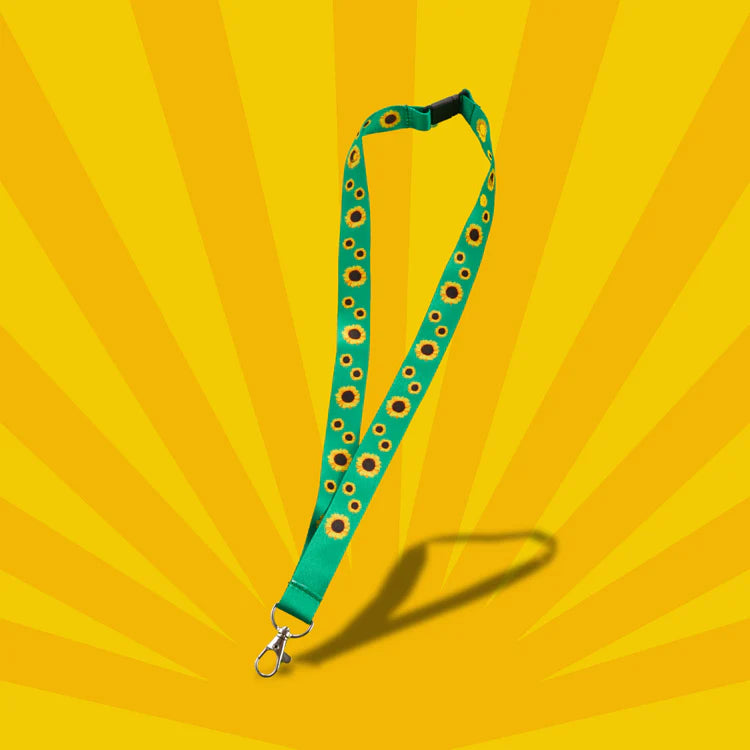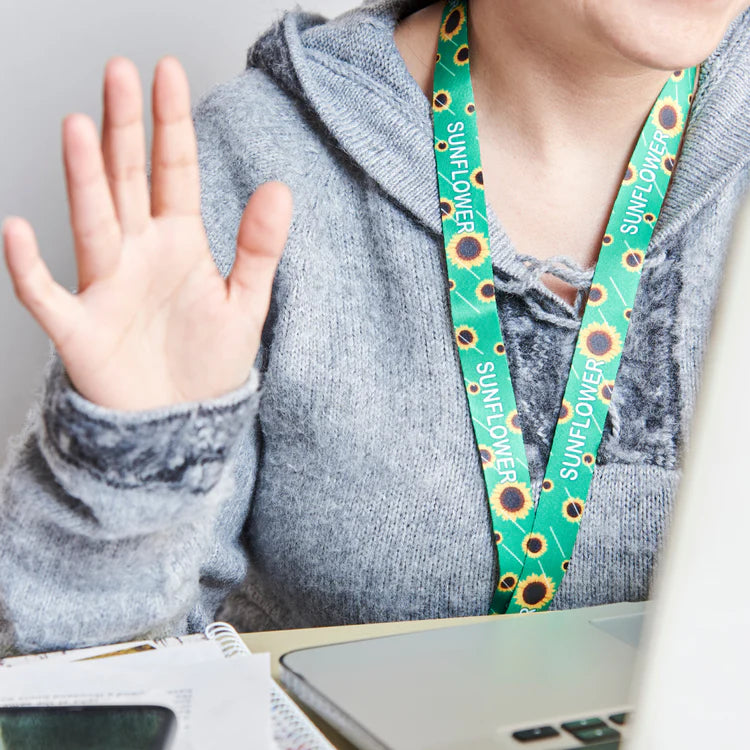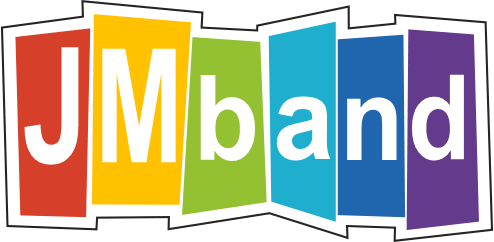
What is a sunflower lanyard?
What is a Sunflower lanyard?
The sunflower lanyard is a green cord with a distinct pattern of sunflowers worn by people with invisible disabilities. It makes it easy for others to recognise that the wearer may need extra help, patience or understanding in different situations. The lanyard is visible and designed to clearly signal the wearer's needs.

Who uses sunflower cord?
The lanyard is an important tool for many people with invisible disabilities who want to communicate their need for space and respect in social situations. This lanyard, also known as a ‘keyhanger,’ is often used by people with autism, ADHD or anxiety who may have difficulty navigating large crowds. The lanyard helps them signal to others that they need extra space and understanding. In addition, sunflower lanyards are used by people with physical movement limitations who want to ensure they have space to move freely. Sunflower lanyards are often used in public transport, schools, supermarkets, festivals, large events and social gatherings.

How to wear a sunflower cord?
The sunflower lanyard, which is a green lanyard with a sunflower motif, is worn to signal that you need extra understanding and support, especially when you have an invisible disability. To put the lanyard on, simply wear it like a regular lanyard. It can easily be hung around the neck or attached to a bag. Many people choose to add a sunflower card explaining their specific needs, which can be placed in a plastic pocket that comes with the lanyard.
The story behind the sunflower cord
The sunflower cord has become a globally recognised symbol that helps people with invisible disabilities signal that they may need extra help, time or patience in everyday life. The idea originated in 2016 at Gatwick Airport in the UK as a collaboration between disability organisations and the airport. The aim was to create a simple and discreet solution to make invisible disabilities more visible in pressurised situations, such as a busy airport.
The Sunflower Lanyard - characterised by the easily recognisable sunflower pattern on a green background - quickly became a success. Demand grew so much that the original collaboration between Gatwick Airport and disability organisations could no longer keep up. This led to the creation of the Hidden Disabilities Sunflower Lanyard Scheme, a private company based in the UK that now runs the programme and is working to expand it globally.
Today, the sunflower lanyard is used in more than 145 international airports worldwide and in many other sectors such as supermarkets, hospitals, transport systems and cultural institutions. In addition to airports, several major companies and institutions in the UK and around the world have also implemented the Sunflower Lanyard as part of their service culture. This makes it easier for people with invisible disabilities to feel safe and accommodated in both everyday and travelling situations.
In Denmark, the sunflower lanyard was introduced in January 2020 by Stine Marsal, then Service Excellence Director at Copenhagen Airport. Soon after, other major Danish airports followed suit, and today it's possible to get a Sunflower lanyard in many places across the country, including hospitals, public institutions and large retail stores. Stine Marsal is now Nordic Regional Director for the Sunflower programme and is actively working to spread it throughout the Nordic region.
The number of people wearing the sunflower lanyard has grown significantly in recent years. Over 2 million sunflower lanyards have been distributed globally and the number continues to grow as more people with invisible disabilities benefit from the programme. It's not just people with physical or mental challenges such as autism, anxiety or dementia who use the lanyard - people with chronic pain, visual impairments and other conditions have also embraced it.
The Sunflower Lanyard has raised awareness that not all disabilities are visible. It helps create a more inclusive society where there is greater understanding and patience, no matter what challenges a person may face.
FAQ
What does a sunflower cord mean?
The sunflower lanyard
is an international symbol used by people with invisible disabilities to signal that they may need extra help, patience or understanding from the outside world. The lanyard is decorated with a recognisable sunflower design and can be worn visibly around the neck. It is designed to allow people with invisible disabilities to communicate their needs without having to explain their situation verbally.
Why are there sunflowers on the sunflower cord?
The sunflowers on the sunflower cord are chosen as a symbol because the sunflower represents visibility and hope in a discreet way. The sunflower is an easily recognisable, bright and positive flower that attracts attention in a non-intrusive way. When a person wears the sunflower lanyard with the sunflower design, it signals to those around them that they have an invisible disability and may need extra patience or support.
What does it take to get a sunflower cord?
To get a sunflower lanyard, you need to have an invisible disability or condition
condition that means you need extra help, understanding or patience from those around you. This could be physical, mental or neurological challenges that are not immediately visible to others, but which affect your ability to cope with everyday activities.
There is no medical documentation required to get a sunflower cord and it is up to the
the individual to assess whether they need the cord. It is a voluntary aid that is offered free of charge in many airports, shops and public places. Alternatively, it can be purchased online or in selected stores. The purpose of the lanyard is to make everyday life easier and less stressful for those who need it by signalling a need for extra consideration.
Is the sunflower cord internationally recognised?
Yes, the sunflower cord has become an internationally recognised symbol of invisible disabilities. It started in the UK but has now spread to many other countries, including Denmark, the US, Canada, Australia and several European countries. This means you can wear the sunflower lanyard when travelling or in international settings and expect people to know what it means.
How do people know what the sunflower cord means?
There are several awareness campaigns, both in Denmark and internationally, that have made people aware of the lanyard and its function. It's still possible that some people don't know about the sunflower lanyard, but its sunflower design is becoming more widespread and recognised.
Who recognises the sunflower cord?
Many organisations and companies in Denmark and internationally recognise the sunflower cord as a symbol of invisible disabilities. This includes airports, supermarkets, public transport and hospitals. These places have often trained their staff to recognise the cord and to offer discreet assistance or patience to those wearing it.
Is there an age limit for wearing the sunflower cord?
No, the sunflower lanyard can be worn by both children and adults with invisible disabilities. There is no restriction based on age, so both younger and older people can benefit from the lanyard. For children, it can be a great help for parents as the lanyard signals that the child may need special consideration without parents having to constantly explain the child's condition.
What is an invisible disability?
An invisible disability is a physical, mental or neurological condition that is not necessarily visible to the naked eye, but can affect a person's quality of life and ability to perform daily activities. This can range from chronic diseases such as fibromyalgia, sclerosis or diabetes, to mental health challenges such as anxiety or depression. Because these conditions are not visible, it can be difficult for those around them to realise that a person needs help or special consideration, which is where the sunflower lanyard can make a big difference.
Are there alternatives to the sunflower cord?
Colour-coded bands or wristbands: Some choose to use colour-coded bands or wristbands that represent different conditions or needs. For example
green bands can signal mental health, while blue bands can be used to represent autism spectrum disorders.
Stickers or badges: Some people use stickers or badges on their bags, clothing or equipment to communicate their needs. These may be specifically
designed to signal that the wearer needs extra help or patience.
Personalised cards:
Carrying a small card that describes your disability and needs can also be
a way to communicate in situations where it is difficult to explain verbally. This can be particularly useful in social situations or when
interaction with public staff.
